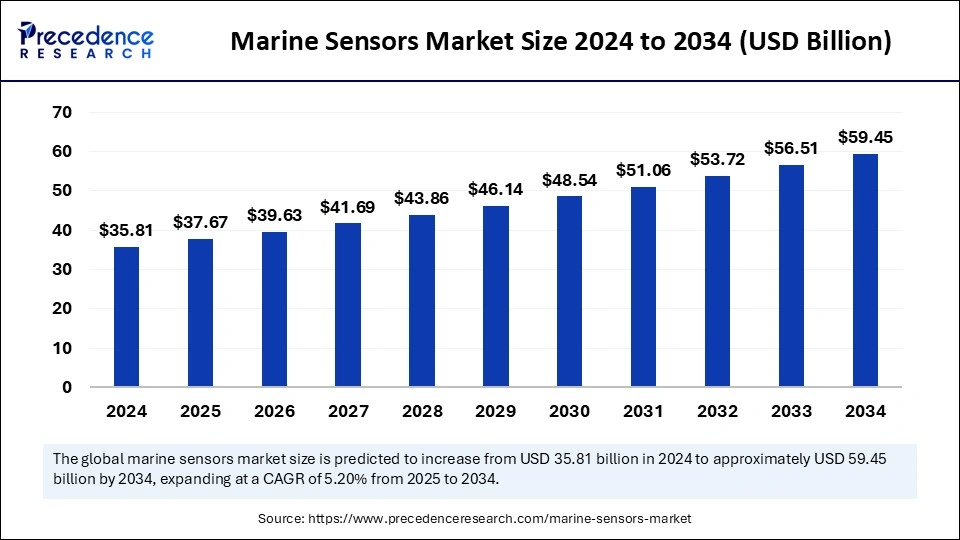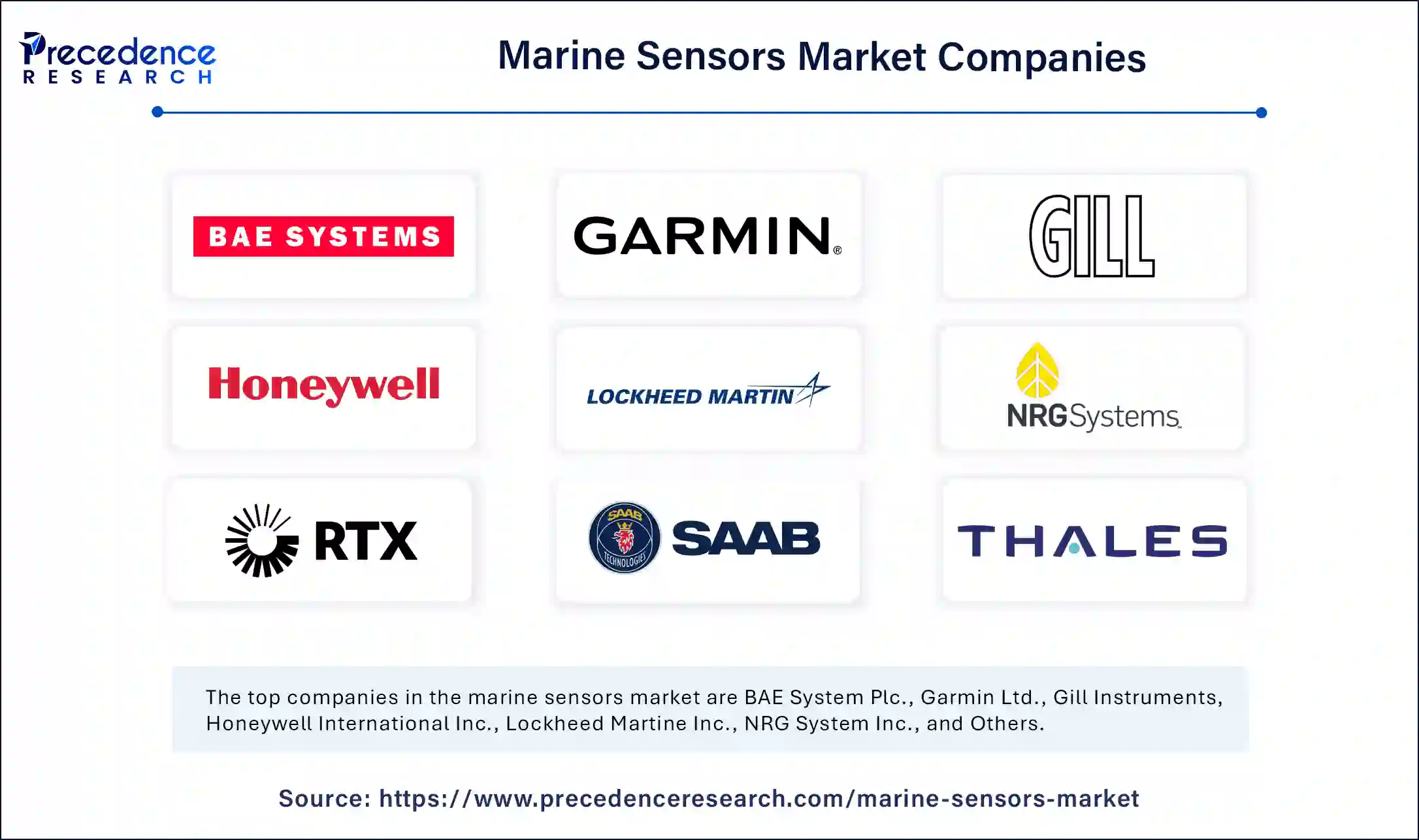Marine Sensors Market Size to Surpass USD 59.45 Bn by 2034
Marine Sensors Market Size and Forecast
The global marine sensors market size was valued at USD 35.81 billion in 2024 and is expected to surpass around USD 59.45 billion by 2034, growing at a CAGR of 5.20% from 2025 to 2034.

Get a Free Sample Copy of the Report@ https://www.precedenceresearch.com/sample/5775
Marine Sensors Market Key Takeaways
-
With a 46% share, Asia Pacific led the global marine sensors market in 2024.
-
North America is anticipated to grow faster than other regions throughout the forecast period.
-
The flow and level sensors category held the dominant market position in 2024.
-
Acoustic sensors are forecasted to show substantial market expansion.
-
Military defense was the top-performing platform segment in 2024.
-
The commercial platform segment is set for the fastest growth trajectory.
-
The largest application share in 2024 came from surveillance and monitoring.
-
The communication and navigation segment is expected to outpace others in growth.
The Rise of Intelligent Marine Sensors: AI’s Impact on Ocean Technology
Artificial Intelligence is playing a transformative role in the marine sensors market by enhancing the accuracy, efficiency, and real-time decision-making capabilities of marine operations. AI-powered algorithms enable smart data processing from sensors, allowing for predictive maintenance, anomaly detection, and advanced environmental monitoring.
These intelligent systems can analyze vast volumes of oceanographic data, such as salinity, temperature, flow, and acoustic signals, much faster than traditional methods. This not only improves the performance of marine sensors but also supports automated systems for surveillance, underwater navigation, and defense applications.
Furthermore, the integration of AI with marine sensors is driving innovation in autonomous underwater vehicles (AUVs) and unmanned surface vehicles (USVs), allowing them to operate with greater autonomy in complex marine environments. AI facilitates adaptive learning and behavioral modeling, enabling these systems to respond to dynamic conditions like changing currents, obstacles, or threats.
As maritime industries—such as oil & gas, naval defense, and environmental research—shift towards smarter, more sustainable operations, AI is emerging as a critical enabler of intelligent, responsive, and data-driven marine sensing solutions.
Market Scope
| Report Coverage | Details |
| Market Size by 2034 | USD 59.45 Billion |
| Market Size in 2025 | USD 37.67 Billion |
| Market Size in 2024 | USD 35.81 Billion |
| Market Growth Rate from 2025 to 2034 | CAGR of 5.20% |
| Dominated Region | Asia Pacific |
| Fastest Growing Market | North America |
| Base Year | 2024 |
| Forecast Period | 2025 to 2034 |
| Segments Covered | Type, Platform, Application, and Regions. |
| Regions Covered | North America, Europe, Asia-Pacific, Latin America and Middle East & Africa |
Market Dynamics
Key Drivers
Defense and surveillance needs are primary drivers, alongside the surge in offshore energy projects and maritime trade. The increasing deployment of autonomous surface and underwater vessels is also accelerating sensor demand, as these platforms rely on advanced sensory input for navigation and obstacle detection.
Opportunities for Growth
There is a strong potential for growth in eco-friendly marine technologies, smart fisheries, and underwater robotics. Innovations in sensor miniaturization and power efficiency could expand their application into new commercial and scientific domains.
Challenges Ahead
Cost barriers, technological complexities, and harsh underwater conditions continue to challenge the reliability and scalability of marine sensors. The need for consistent calibration and maintenance also impacts long-term deployment and usability.
Regional Landscape
The Asia Pacific region dominates the market due to robust investments in naval capabilities and maritime research. North America follows closely, with ongoing efforts in modernizing naval fleets and advancing marine technologies. Europe remains a significant player, especially in the environmental monitoring segment.
Marine Sensors Market Companies

- BAE System Plc. (U.K.)
- Garmin Ltd. (U.S.)
- Gill Instruments (India)
- Honeywell International Inc. (U.S.)
- Lockheed Martine Inc. (U.S.)
- NRG System Inc. (U.S.)
- Raytheon Company (U.S.)
- SAAB AB (Sweden)
- Thales Group (France)
Recent Developments
- In March 2024, a pioneer in research-quality conductivity-temperature sensors for mobile marine platforms, Neil Brown Ocean Sensors, Inc., launched its latest innovation ahead of Oceanology International 2024 in London. The aim behind this launch was to redefine underwater data collection and address an increasing demand for smaller, more capable unmanned underwater vehicles (UUVs) in various industries.
- In December 2024, Vaisala launched a robust ultrasonic wind sensor for optimized maritime performance and wind turbines. This sensor is designed to withstand the unique challenges and wide range of conditions in both maritime environments and wind farms.
Segments Covered in the Report
By Type
- Acoustic Sensors
- Magnetic Sensors
- Sonars
- Pressure Sensors
- Temperature Sensors
- Flow and Level Sensors
- Others (Magnetometer, Infrared Sensors, Seismic Sensors)
By Platform
- Military and Defense
- Commercial
By Application
- Intelligence and Reconnaissance
- Communication and Navigation
- Electronic Warfare
- Target Recognition
- Surveillance and Monitoring
- Others (Combat Operations and Command and Control)
By Region
- North America
- Europe
- Asia Pacific
- Latin America
- Middle East and Africa
Also Read: Aviation Connector Market
Ready for more? Dive into the full experience on our website@ https://www.precedenceresearch.com/
